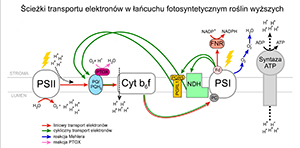The role of alternative electron pathways in the photosynthetic chain in higher plants
DOI:
https://doi.org/10.18388/pb.2021_465Abstract
Light-dependent reactions of photosynthesis takes place in the thylakoids of chloroplasts where light energy harvested from the sun drives the synthesis of ATP and NADPH. The major pathway of photosynthetic chain is the linear electron transport (LET), in which both photosystems (PSI and PSII) are involved, and ATP and NADPH are produced. However, ratio in production of those components is insufficient to cover the Calvin cycle energy requirements, depending on the metabolism of the cell. Moreover, disturbance in metabolism homeostasis, caused by environmental stress conditions, increases ATP demand, which cannot be covered by LET. Thus, in photosynthetic apparatus must exist alternative electron transport pathways, these include: cyclic electron transport (CET) mediated by NDH complex or PGR5/PGRL1 proteins, water-water cycle and PTOX enzyme. Activity of alternative pathways can optimize ratio in production of ATP/NADPH, appropriately to requirements, which allows to achieve redox balance and ATP contents.

Published
Issue
Section
License
Copyright (c) 2022 Aleksandra Urban, Marta Galas, Paweł Rogowski

This work is licensed under a Creative Commons Attribution 4.0 International License.
All journal contents are distributed under the Creative Commons Attribution-ShareAlike 4.0 International (CC BY-SA 4.0) license. Everybody may use the content following terms: Attribution — You must give appropriate credit, provide a link to the license, and indicate if changes were made, ShareAlike — If you remix, transform, or build upon the material, you must distribute your contributions under the same license as the original. There are no additional restrictions — You may not apply legal terms or technological measures that legally restrict others from doing anything the license permits.
Copyright for all published papers © stays with the authors.
Copyright for the journal: © Polish Biochemical Society.



